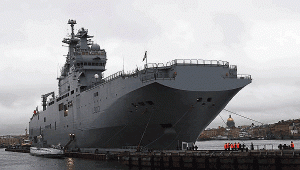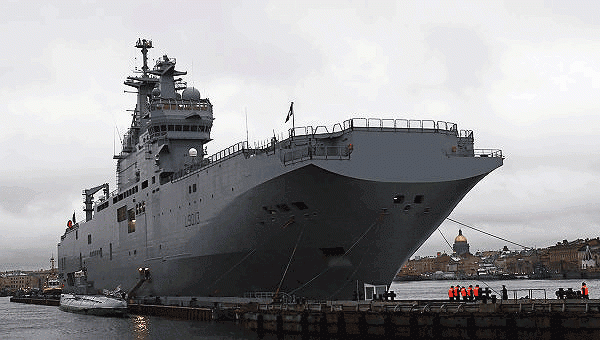
(Pictured: Mistral warship, two of which France sold to Russia.)
Russia is set to increase its defense spending by 60 percent, from $42 billion in 2010 to $66.3 billion by 2013. This news is several months old, but the recent remarks of Russian President Dimitry Medvedev, coupled with the completion of an arms deal for two French warships, with the possibility of two more to follow, has drawn attention to Russia’s military modernization program. By itself, the deal with France has drawn considerable notice, as it is the first time a NATO member has sold such sophisticated weaponry directly to Russia. France has defended its decision in purely economic terms, and as an opportunity to improve relations between NATO and Russia. However, other NATO members, most notably the United States, have been skeptical of what they see as a potentially dangerous reversion to Cold War-style militarism by the Kremlin.
Russia is intent to embark on a vigorous modernization program aimed at several areas. In particular, officials have enunciated the need to modernize an aging navy, as well as place ‘special emphasis’ on aerospace defense and the need to keep pace with other modern air forces. Indeed, these areas are likely to receive the majority of new defense funds. Along with the recently completed purchase of two French Mistral class helicopter carriers-amphibious assault ships, the increased defense budget will include allocations for three Talwar class frigates, three Improved Kilo class submarines as well as several advanced Yasen and Borei class submarines. In addition to the increased focus on naval modernization, Russia plans to direct significant funds towards reinforcing its air force. This will include significant additions of Su-family fighter aircraft, MiG-29K Fulcrum-D carrier-based fighters as well as Su-34 Flanker fighter-bombers.
It comes as no surprise that Russia should embark on a large-scale overhaul of its military, much of which still relies on Soviet-era equipment and methods. In particular, Russian military performance in the 2008 war with Georgia, continued conflict in Chechnya and the failure to keep pace with NATO, have helped sustain the drive to increase defense spending. However, of concern is the potential of modernization coupled with a reversion to out and out hard-power balancing. In his recent address to the Federal Assembly, President Medvedev, warned that failure to reach agreement with NATO over a European missile defense system may induce another arms race.
This seems particularly salient given Russia’s intent to use its increased budget to bolster its submarine fleet, in particular, by acquiring additional Borei and Yasen class submarines. The Borei class ballistic missile submarine is designed to enhance Russian second-strike capability, thereby ensuring nuclear deterrence. The Borei class sub is designed “to stay submerged for extended periods and launch long-range missiles in case of nuclear war.” The Yasen class attack submarine is designed to neutralize enemy maritime assets, particularly enemy ballistic missile submarines. Moreover, it is likely that these assets will be presented to Russia’s Black Sea Fleet, placing them in ideal positions should conflict ensue with Europe. Based on these planned acquisitions, it seems clear that Russia continues to focus on the perceived threat emanating from NATO, and although relations have warmed between the two, Russia still believes a strategic hedge is in its best interest.
However, questions remain over exactly how the Russian government plans to pay for such a significant increase in defense spending, particularly given Russia’s economic situation and a rising need to address a shrinking population. Indeed, in his recent speech, Medvedev made clear that a major goal was initiating programs aimed at boosting the Russian population. Balancing defense spending with necessary social programs will likely prove to be difficult in an uncertain financial climate.
Despite arduous financial constraints, weapons sales are likely to help significantly offset the costs of modernization. After a several year hiatus, it appears that China is ready to resume buying high-end Russian weapons systems and aircraft. Sales of the fourth-plus generation fighter, the Su-35 along with military transport planes and air refueling tankers, as well as anti-aircraft systems will net a huge windfall for the Russian defense industry. Indeed, China’s modernization program, thoroughly reliant on imported Russian weapons technology, may help Russia fund its own modernization program.
Having seen its military forces struggle in several low-level conflicts and amid concerns over losing even more ground to NATO military power, Russia is set to engage in a large-scale military overhaul. Although relations have warmed significantly between Russia and the West in the past two decades, and despite very serious efforts to reach out to and include Russia in global governance, some even arguing for Russia’s admittance into NATO, it seems that shaking off a Cold War outlook remains difficult.
Greg Chaffin is an Intern/Research Assistant with Foreign Policy in Focus.

